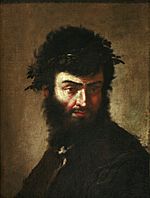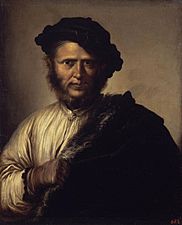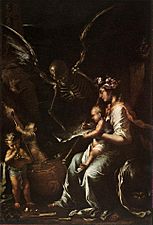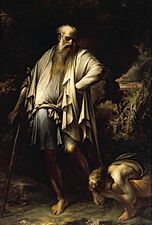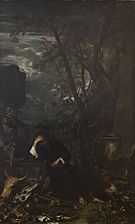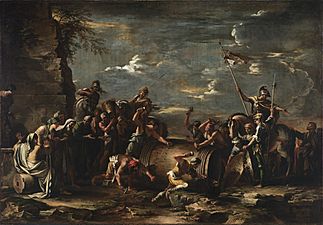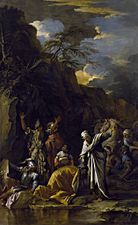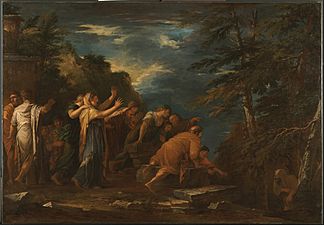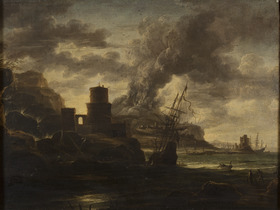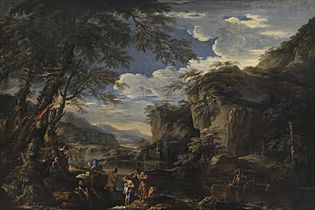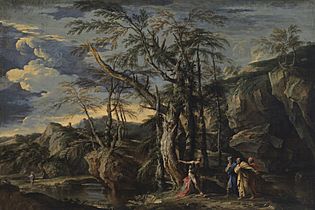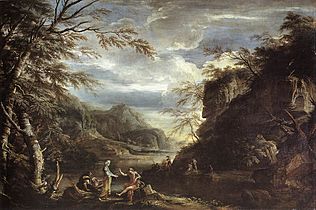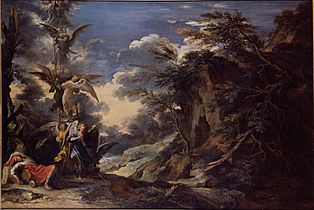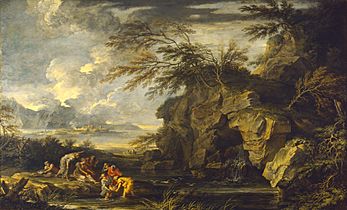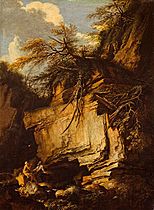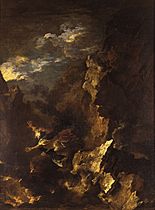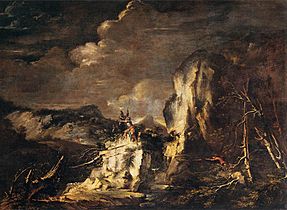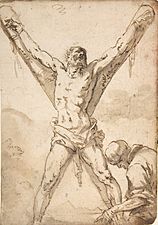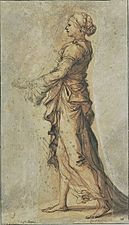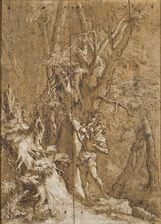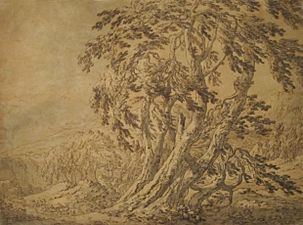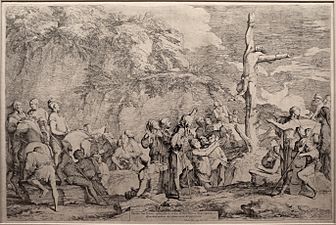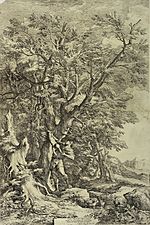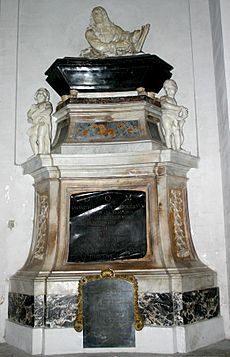Salvator Rosa facts for kids
Quick facts for kids
Salvator Rosa
|
|
|---|---|
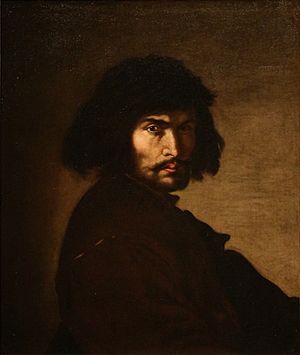
Self Portrait (ca. 1650s), oil on canvas, 75 x 62.5 cm., Detroit Institute of Art.
|
|
| Born | June 20 or July 21, 1615 Arenella, Kingdom of Naples
|
| Died | March 15, 1673 (aged 57) |
| Nationality | Italian |
| Known for | Painting, printmaking, poetry |
| Movement | Baroque |
Salvator Rosa (1615–1673) was a famous Italian Baroque painter. He was known for his unique landscapes and history paintings. These artworks often showed wild, untamed nature and had a big impact from the 1600s to the early 1800s.
During his life, Salvator Rosa was one of the most well-known painters. People knew him for his lively personality. He was also a talented poet, writer of satires (funny but critical writings), actor, musician, and printmaker. He worked in Naples, Rome, and Florence. Sometimes, he had to move between cities because his sharp satires made him enemies among artists and thinkers.
As a history painter, he often chose unusual subjects from the Bible, myths, and the lives of philosophers. Other artists rarely painted these topics. He did not often paint common religious scenes unless they allowed him to focus on the landscape. He also created battle scenes, allegories (pictures with hidden meanings), scenes of witchcraft, and many self-portraits.
However, he is most famous for his very original landscapes. These paintings showed "sublime" nature, which means wild and powerful. The people in these paintings often seemed small compared to the vast natural world. His landscapes were very different from the calm, classical scenes by artists like Claude Lorrain. They were early examples of Romantic landscapes.
Some experts say his painting skills were not always as good as his amazing ideas. This is partly because he painted many canvases quickly when he was young to earn money. Rosa himself later disliked these early works. Many of his landscapes with people in them ended up in England and France by the 1700s. He was more famous in these countries than most other Italian Baroque painters.
Rosa has been called "unusual and over-the-top" and a "constant rebel." He greatly influenced the Romantic art movement. He became a very popular figure in the late 1700s and early 1800s. Many stories and legends grew around his life. People sometimes mixed up his real life with the bandits and outsiders he painted in his wild, stormy landscapes.
By the mid-1800s, with new art styles like realism and Impressionism, his work became less popular. It received very little attention for a while. But in the late 1900s, people became interested in his paintings again. Today, art historians see him as an important and creative landscape painter. He is also considered a key figure who helped start the Romantic movement.
Contents
Biography
Early Life and Art Training
Salvator Rosa was born in Arenella, near Naples, on June 20 or July 21, 1615. His mother, Giulia Greca Rosa, came from a Greek family in Sicily. His father, Vito Antonio de Rosa, was a land surveyor. He wanted Salvator to become a lawyer or a priest. So, he sent him to a religious school.
But Salvator loved art. He secretly learned about painting from his uncle, Paolo Greco. Soon, he went to study with his brother-in-law, Francesco Fracanzano. Fracanzano was a student of the famous painter Ribera. Salvator also studied with either Aniello Falcone or Ribera himself. Some stories say he even lived with groups of traveling bandits for a time.
When Salvator was seventeen, his father died. His mother was left with at least five children and no money. Salvator had to support his family. He continued to learn from Falcone, helping him paint battle scenes. It is said that another famous painter, Giovanni Lanfranco, noticed Salvator's work. Lanfranco told him to go to Rome, where Salvator stayed from 1634 to 1636.
After returning to Naples, he began painting haunting landscapes. These showed wild plants, jagged beaches, mountains, and caves. Rosa was one of the first artists to paint "romantic" landscapes. He often included rugged, stormy scenes with shepherds, bandits, sailors, or soldiers. He sold these early landscapes cheaply through art dealers.
He went back to Rome in 1638–1639. There, Cardinal Francesco Maria Brancaccio gave him a place to stay. For a church in Viterbo, Rosa painted The Incredulity of Thomas. This was one of his first and few altarpieces (paintings for an altar).
Family Life
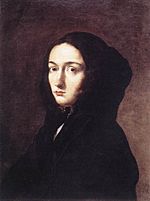
In 1640, Rosa met Lucrezia Paolini in Florence. She became his lifelong partner. Their first son, Rosalvo, was born in 1641. Another son, Augusto, was born in 1657. Rosa and Lucrezia were very devoted to each other.
Later, in 1656, Rosa felt pressure in Rome from some powerful people. He sent Lucrezia and Rosalvo to stay with his family in Naples. Soon after she arrived, a serious outbreak of the plague hit Naples. Sadly, Rosalvo, Salvator's brother, sister, and their children all died. Lucrezia survived and returned to Rome alone. Their son Augusto was born the next year.
Near the end of his life, Salvator Rosa was not well. He married Lucrezia on March 4, 1673. He died on March 17. After his death, a list of items in his house showed that the Portrait of Lucrezia Paolini was displayed in an important spot. It was one of the few paintings he still owned.
Artistic Career and Challenges
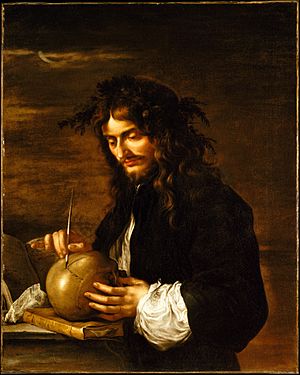
Salvator Rosa was a talented painter, but he also enjoyed many other arts. He was a musician, poet, writer, etcher, and actor. In Rome, he became friends with Pietro Testa and Claude Lorrain. During a Roman carnival, he wrote and performed in a play. In it, his character gave out funny "prescriptions" for problems of the body and mind. He also criticized the comedies put on by Bernini.
His plays were popular, but they also made powerful enemies among artists and patrons, including Bernini. Around 1640, he moved to Florence at the invitation of Giovanni Carlo de' Medici. He stayed there until 1649. In Florence, Rosa started a group of poets, playwrights, and painters called the Accademia dei Percossi (Academy of the Stricken). He showed his wild landscapes to the strict art world of Florence. While he influenced many, he had few true students.
A passage in one of his satires suggests he supported the 1647 uprising led by Masaniello. Rosa even painted Masaniello's portrait. Rosa's intense art and his reputation as a rebel led to a popular legend. This story said that Rosa lived with a group of bandits and took part in the Naples uprising against Spanish rule. Even though these actions do not fit with the known dates of his career, a famous romantic ballet called Catarina was created about this story in 1846.
He returned to Rome in 1649. There, he focused more on large paintings. He chose unusual themes and stories for painters of the 1600s. These included Democritus amid the Tombs and The Death of Socrates. His painting Allegory of Fortune caused a big argument. Religious and civil leaders thought it was a satire aimed at them, and Rosa was almost arrested. Around this time, Rosa wrote his satire called Babylon.
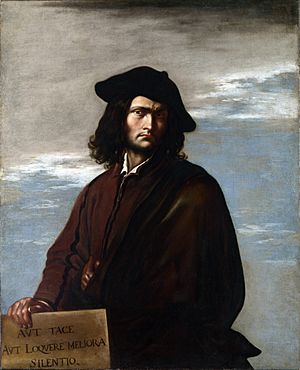
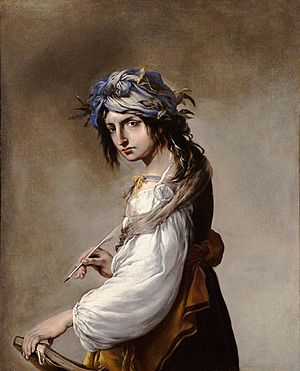
His criticisms of Roman art culture made him more enemies. Some people claimed his published satires were not his own. Rosa strongly denied these claims. It is possible that his friends in Florence and Volterra helped him with the topics of his satires. But he created the actual writings himself. To prove his critics wrong, he wrote the last of his satires, called Envy.
Among his last paintings were Saul and the Witch of Endor and a Battlepiece, both now in the Musée du Louvre. The battle scene was painted in just 40 days. Other late works include Polycrates and the Fishermen and the Oath of Catiline.
While working on a series of satirical portraits, Rosa became ill. He died about six months later. In his final moments, he married Lucrezia. His tomb is in Santa Maria degli Angeli e dei Martiri in Rome. Salvator Rosa, after a difficult youth, had become quite wealthy.
He was also an important etcher. He created a very popular series of small prints of soldiers. He also made several larger and more complex prints.
Legacy

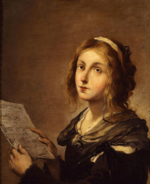
During Rosa's lifetime, his work inspired other artists like Giovanni Ghisolfi. But his biggest impact was on the development of romantic and "sublime" landscapes in painting. "Sublime" means awe-inspiring and powerful. Artists in the 1700s who were influenced by Rosa include Alessandro Magnasco and Marco Ricci.
Rosa himself did not think his early landscapes were as important as his history paintings. But his history paintings often limited his rebellious style. He usually avoided the calm, peaceful countryside scenes painted by artists like Claude Lorrain. Instead, he created dark, thoughtful fantasy landscapes, often with ruins and bandits. By the 1700s, people often compared Rosa's "sublime" landscapes with Claude's "picturesque" (pretty) ones.
In a time when artists were often controlled by their patrons (people who paid for their art), Rosa was very independent. He celebrated the special role of the artist. He refused to paint on commission or agree on a price beforehand. He chose his own subjects. He said he painted "...purely for my own satisfaction."
Salvator Rosa and Romanticism
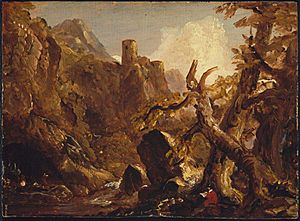
Rosa's influence on Romanticism in the late 1700s and early 1800s was huge. Art historians have called him a "cult figure." They say he "started the romantic landscape" and began the "cult" of the sublime landscape. One of the first signs of the Romantic movement in the early 1700s was the English landscape garden. Rosa's paintings, along with those of Claude Lorrain and Nicolas Poussin, were key inspirations. William Kent, who created natural-looking gardens, admired Rosa greatly. He even planted dead trees in his gardens to get a "Salvator Rosa effect."
One historian noted that much of Rosa's fame in England came from stories and writings about him. His impact went far beyond just painting. In his book A Philosophical Enquiry into the Origin of Our Ideas of the Sublime and Beautiful (1757), Edmund Burke called Salvator Rosa the "painter of the Sublime." Famous writers like Horace Walpole and Percy Bysshe Shelly praised his paintings. His name became a symbol for qualities loved by Romantics. These included "wild power, terror, greatness, surprise, and pleasing horror."
Many stories about Rosa's life were published. They often included made-up tales. Salvator Rosa was the name of a 19th-century Italian opera. A ballet called Catarina was also inspired by the legend of Rosa's dealings with bandits. The composer Franz Liszt even included a song called "Canzonetta del Salvator Rosa" in one of his piano collections.
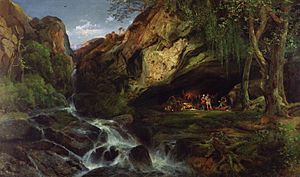
Rosa and his wild spirit became very popular with British Romantics. His influence can be seen in the work of artists like John Martin and William Turner. Rosa also influenced American art of that time. Thomas Cole saw Rosa as one of his heroes. His impact is also seen in the work of artists like Washington Allston and Thomas Moran.
Rosa's fame and influence decreased in the 1800s. In 1843, when his painting Monks Fishing was shown, John Ruskin criticized it. He said it told "unmitigated falsehoods" and ignored the "laws of nature." However, since the 1970s, scholars have paid renewed attention to Rosa's work. There have been museum shows, books about his art, and publications of his letters.
Galleries
Paintings
-
Portrait of a Man (1640s), oil on canvas, 78 x 65 cm., Hermitage Museum)
-
Heroic Battle (ca. 1652–1664), oil on canvas, 214 x 351 cm. Louvre
-
Human Fragility (ca. 1656), oil on canvas, 199 x 134 cm., Fitzwilliam Museum
-
Diogenes Casting Away his Cup (1650s), oil on canvas, 219 x 148 cm., private collection
-
Democritus in Meditation (1650–51), oil on canvas, 344 x 214 cm., National Gallery of Denmark
-
The Death of Regulus (ca. 1650–1652), oil on canvas, 152.4 × 219.71 cm., Virginia Museum of Fine Arts
-
The Baptism of the Eunuch (ca. 1660), oil on canvas, 200 x 122 cm., Chrysler Museum of Art
-
Pythagoras Emerging from the Underworld (1662), oil on canvas, 131 x 189 cm., Kimbell Art Museum
Landscapes
-
Landscape with a Bridge (1645–49), oil on canvas, 106 x 127 cm., Galleria Palatina
-
Saint John the Baptist Baptizing Christ in the Jordan (ca. 1655) oil on canvas, 173 x 258.7 cm., Kelvingrove Art Gallery and Museum
-
Saint John the Baptist Revealing Christ to the Disciples (ca. 1655) oil on canvas, 173.4 x 260.7 cm., Kelvingrove Art Gallery and Museum
-
Bandits on a Rocky Coast (ca. 1655), oil on canvas, 74.9 x 100 cm., Metropolitan Museum of Art
-
Apollo and the Cumean Sibyl (1657–58), oil on canvas, 173.7 x 259.5 cm., Wallace Collection
-
Mercury and the Dishonest Woodsman (ca. 1663), oil on canvas, 125.7 x 202.1 cm., National Gallery
-
The Finding of Moses (1660–65), oil on canvas, 123.2 × 202.6 cm., Detroit Institute of Arts
-
St. Anthony Abbot and St. Paul the Hermit (ca. 1660–65), oil on canvas, 67.3 x 49.9 cm., National Gallery of Scotland
-
The Death of Empedocles (ca.1665–70), oil on canvas, 135 x 99 cm., private collection
-
Rocky Landscape with a Huntsman and Warriors (ca. 1670), oil on canvas, 142 x 192 cm., Louvre
Drawings
All drawings are undated: pen, ink, and wash; or pen, ink, wash, and chalk on paper
-
Turbaned Warrior Holding a Mace (13.2 x 8.2 cm.), Metropolitan Museum of Art
-
Martyrdom of St. Andrew (19.8 x 13.7 cm.), Metropolitan Museum of Art
-
Woman standing draped (25.4 x 14.7 cm.), Louvre
-
Forest Scene, Honolulu Museum of Art
Prints
All prints are etchings, or etchings with drypoint
Works About Rosa
Many stories and books have been written about Salvator Rosa's life, some of them fictional.
- Salvator Rosa is a 19th-century Italian opera.
- The 1846 ballet Catarina was inspired by the story of Rosa and the bandits.
- The composer Franz Liszt included a song titled "Canzonetta del Salvator Rosa" in his piano music.
See also
 In Spanish: Salvator Rosa para niños
In Spanish: Salvator Rosa para niños


